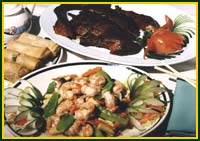Language
Marriage
Family
Sexuality
Gender
Religion
Arts
Bibliography
Normally, one entree will combine three to five colors. There are often one main ingredient and two to three secondary ingredients of contrasting colors. They are cooked appropriately, incorporating the proper seasonings and sauce to create an aesthetically attractive dish.
As an essential factor of a kickshaw, fragrant aroma will certainly stimulate one's appetite. The main ingredients that contribute to a mouthwatering aroma are scallion, fresh ginger, garlic, and chili pepper. Besides, wine, aniseed, stick cinnamon, pepper, and sesame oil also function. Soy sauce and sugar, vinegar and other seasonings can also be used to add richness to a course without covering up the natural flavor of the ingredients.
Taste is the most important essence of a perfect dish. A well-prepared Chinese dish should taste rich to those who like strong flavors, but not over-spiced to those who seek a milder taste.
In China, due to vast territory and multitudinous nationalities, there are various minority foods.
Hui Cuisine:
The Hui minority likes to eat ruminant animals' meat and vegetarian animals and poultry which must be butchered by Muslim priest, called Ahong in Chinese. Meat of pig, mule, horse and donkey and blood are all taboos to them.
The Hui Minority's famous cuisine includes steamed lamb, lamb eaten with hands, fried beef, grilled mutton kebab, deep-fried food and so on. The Hui cuisine enjoys high reputation in China for its deliciousness. Usually, Hui minority will add Sanxian soup (soup extracted out of beef, mutton and chicken) into their food.
Hui Cuisine, called Qingzhen (pure and true), can be found almost in every city in China.
Tibetan Cuisine:
Tibetan cuisine is divided into two types: those of the pastoral and farming areas. The pastoral nomads basically consume meat and milk. Mutton and other types of meat, sometimes dried, are eaten in winter, while yogurt and cheese in summer. These foods are rich in protein and calories, but greasy. Green tea usually accompanies Tibetan meals. The farming population is fond of Zamba (roasted Qingke barley flour), Qingke wine, pork and potatoes.
Tibetans have mild palates. Salt, garlic and green Chinese onion are the only seasonings they use. Of course, if guests like spicy food, the versatile Tibetan chefs can satisfy their appetites.
There are more than 60 varieties of typical Tibetan dishes, such as rice with milk and meat dumplings in sparerib soup. Tibetan snacks include yak blood cubes, which are made by the following procedures. Draw 0.25 kg of blood from the veins of a yak, then pour it into a pan and boil it on a slow fire until the blood solidifies, cut it into cubes, pour hot butter on them and then add white sugar.
Lhasa has more than 100 Tibetan-style restaurants, with painted wooden tables, iron stoves, and porcelain bowls and religious statues. Tourists can choose from a variety of sausages, Zamba, beef or mutton eaten with the fingers, cold yak tongues dressed with sauce, noodles, buttered tea, sweet tea and milk tea.
